Hydraulic accumulators are expansion or membrane tanks. The device and principle of operation for the water supply and heating systems are the same, although their functions differ. We suggest you understand the features of hydraulic accumulators, how to choose and install them in own house with your own hands.
What is a hydraulic accumulator for?
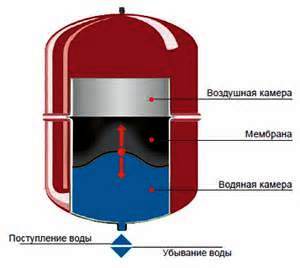
A hydraulic accumulator for heating, in case of a system breakthrough or a decrease in temperature near the water, makes up for its missing volume in pipes and radiators. It also allows you to drive the accumulated air in the pipes.
The heating system is a ring with water circulating in it. When heated in the system, the water increases in volume, and the capacity of the circuit does not change. The hydraulic accumulator for the heating system takes excess water into itself. This allows you to equalize the pressure and not bring the water to a boil. If this happens, the connections of the pipes and the heat exchanger housing and other elements of the housing may leak.
How to choose a hydroaccumulator for heating
Hydraulic accumulators differ in type, they can be closed and open.
Open is rarely used due to the demanding maintenance and some other shortcomings in operation. The closed type of accumulator is installed in similar systems. Such a tank is an oval, round iron cylinder with a chamber (rubber) inside.
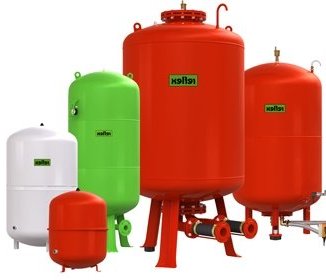
Expansion tank
With a small amount of water in the heating system, a tank is taken with a membrane vessel inside. The larger the tank, the higher the cost. The price also depends on the brand and design features. For small houses a relatively small hydraulic accumulator is needed.
Before buying an expansion tank, it is worth calculating the required volume for it. When installing after the pump for water supply, it is impossible to install a hydraulic accumulator, otherwise sudden pressure drops may occur.
Installation of a heating accumulator
The expansion tank must only be installed in a heated room. If the weight of the accumulator exceeds 30 kilograms, then it is installed on a special stand. The location for the expander should be easily accessible for maintenance.
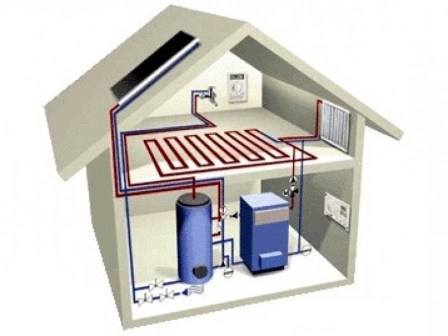
Heating and water supply systems
The insert is made into the pipes only on the return line. The insert is made between the final radiator, close to the boiler. Installed in front of the expansion tank check valve and a manometer for constant measurement of pressure in the system.
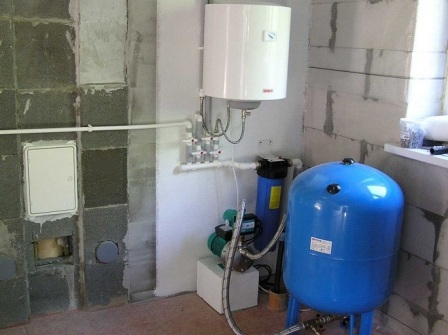
It is best to choose a model with a replaceable membrane, which is replaced in the event of a breakdown without much effort. If possible and desired, the accumulator can be installed without outside help, but if you are not sure or do not want to mess around for a long time, you can hire a specialist. However, in this case, you will not be able to save.
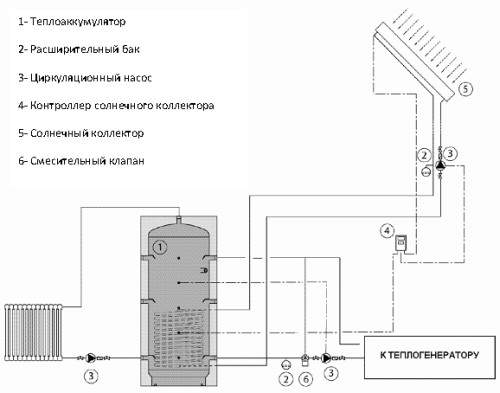
Heat accumulator in solar heating system
Now you know the device and principle of operation of the accumulator, so you can choose the right model for your country house. A properly installed heating system is a guarantee of comfort and warmth in the cold season. We hope that the articles from our site will be useful to you when building a house, furnishing suburban area and spending time with family.
Hydraulic accumulators are expansion or membrane tanks. The device and principle of operation for the water supply and heating systems are the same, although their functions differ. We invite you to understand the features of hydraulic accumulators, how to choose and install them in your own home with your own hands.
What is a hydraulic accumulator for?
There are several types of accumulators that are used to operate heating or water supply systems. So for heating is taken expansion tank, which easily tolerates high water temperatures. This is what distinguishes it from a hydraulic accumulator for water supply. When water boils, he takes it into the tank.
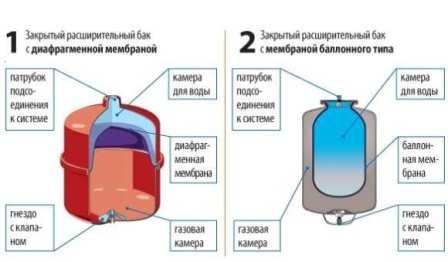
Useful article: Why do we need a hydraulic accumulator for water supply systems
A hydraulic accumulator for heating, in case of a system breakthrough or a decrease in temperature near the water, makes up for its missing volume in pipes and radiators. It also allows you to drive the accumulated air in the pipes.
The heating system is a ring with water circulating in it. When heated in the system, the water increases in volume, and the capacity of the circuit does not change. The hydraulic accumulator for the heating system takes excess water into itself. This allows you to equalize the pressure and not bring the water to a boil. If this happens, the connections of the pipes and the heat exchanger housing and other elements of the housing may leak.
How to choose a hydroaccumulator for heating
Hydraulic accumulators differ in type, they can be closed and open.
Open is rarely used due to the demanding maintenance and some other shortcomings in operation. The closed type of accumulator is installed in similar systems. Such a tank is an oval, round iron cylinder with a chamber (rubber) inside.
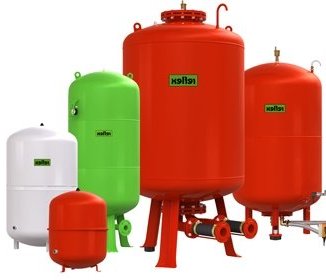
Expansion tank
With a small amount of water in the heating system, a tank is taken with a membrane vessel inside. The larger the tank, the higher the cost. The price also depends directly on the brand and design features. For small houses, a relatively small accumulator is needed.
Before buying an expansion tank, it is worth calculating the required volume for it. When installing after the pump for water supply, it is impossible to install a hydraulic accumulator, otherwise sudden pressure drops may occur.
Installation of a heating accumulator
The expansion tank must only be installed in a heated room. If the weight of the accumulator exceeds 30 kilograms, then it is installed on a special stand. The location for the expander should be easily accessible for maintenance.
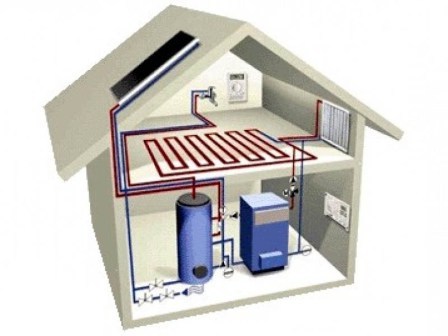
Heating and water supply systems
The insert is made into the pipes only on the return line. The insert is made between the final radiator, close to the boiler. A non-return valve and a pressure gauge are installed in front of the expansion tank to constantly measure the pressure in the system.
![]()
It is best to choose a model with a replaceable membrane, which is replaced in the event of a breakdown without much effort. If possible and desired, the accumulator can be installed without outside help, but if you are not sure or do not want to mess around for a long time, you can hire a specialist. However, in this case, you will not be able to save.

Heat accumulator in solar heating system
Also read: How to lay plumbing in the house
Now you know the device and principle of operation of the accumulator, so you can choose the right model for your country house. A properly installed heating system is a guarantee of comfort and warmth in the cold season. We hope that the articles from our site will be useful to you when building a house, arranging a summer cottage and spending leisure time with your family.
A membrane expansion tank (hydraulic accumulator) is a mandatory component of the heating system (hereinafter CO), without which normal functioning is impossible, especially for heating systems closed type. The tank compensates for critical drops in water volume and pressure, which are the result of its heating and, as a result, an increase in volume. With a properly selected hydraulic accumulator, the possibility of water hammer and interruptions in the heating operation is excluded.
The principle of operation and function of the expansion tank
- accumulation or temporary removal of excess coolant during its expansion;
- removal of air from pipes.
At high temperatures The water expands and the volume and pressure inside the pipes increases. The increasing volume of water goes into the tank. If you do not secure the system, then the water will simply pour out if it is a system open type, and in the case of a closed system, pipes may burst.
Another important task of the expansion tank is de-airing. When used in natural circulation heating, the tank is mounted at its highest point - attic areas or closer to the ceiling of the boiler room. The height of the installation depends on the layout of the pipes, how and where they pass, but the tank must always be located above other elements.
At forced circulation closed-type expansion tank can be installed anywhere, also on the floor: pressure is created here circulation pump, it provides the necessary pressure in all areas. Devices for air injection - valves of varying complexity, which can be already installed on the body or additionally installed on couplings around the hose. A prerequisite for such an arrangement of the expansion tank closed system- the presence of a pump for circulation.
Device and functions
 The expansion tank may have different design for two ways of functioning of the system:
The expansion tank may have different design for two ways of functioning of the system:
- closed;
- open and top spill.
In an open system, the expansion tank for heating is a simple vessel open on top, it may not be airtight. There is a lid, but only to protect against debris. Water must be periodically added to the tank - this compensates for evaporation.
Membrane tanks are used in modern system closed type. They are sealed, the segments inside are separated by an elastic membrane to prevent oxygen saturation of the coolant (this leads to pipe corrosion).
Expansion tank in an open heating system
For open systems are typical:
- natural circulation;
- constant contact of fluid with air. The tank here has a dual purpose: it holds the excess volume of water and removes the displaced air;
- the entire open CO circuit is laid with a slight slope along the entire length.
With these methods, the expansion tank is located at the highest point of the system. Filling with wiring should have a slope to ensure the displacement of air into the container. There are situations when it is difficult or impossible to provide a slope along the entire length of the contour. Then, on the "pocket" where air accumulates, another tank is mounted at the same level as the main one. With a small pocket (1-3 radiators), an ordinary “vent” for air is enough.
If the pump provides water movement, then the blockage is not terrible, but the problem of airing, of course, remains: the air in the cavities of the mechanisms leads to corrosion, and the constant gurgling in the pipes leads to unnecessary noise. In this case, installation at a high point in the circuit is not necessary: the tank is located in the segment with the least amount of turbulence in the water flow.
The classic place is a straight piece of pipe in front of the pump. In this section, the movement of the liquid is closest to the laminar type, which minimizes pressure surges in the tank.
Closed way of installing a heating system
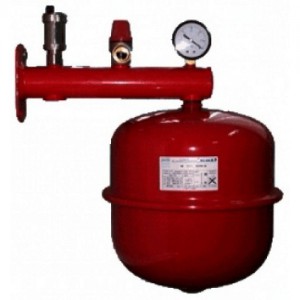
In a closed type mechanism, the tank provides compensation for the expansion of water when heated. If it is not installed, the pipes may break due to the pressure increasing due to heating. The tank in this case is a sealed vessel that does not come into contact with the environment and is produced on specialized equipment. The tank of the closed type has two parts separated by an elastic membrane: the lower one is for excess water volume, the upper one is for air or gas. They compensate for expansion and create optimal pressure.
The upper part of the tank is equipped with a nipple for pumping air inside - in this way the pressure is equalized. The installation must be carried out on a segment with close to laminar flow: for example, on the return line before the circulation pump. In this case, the site must be straight, horizontal.
The modern expansion tank is already equipped with pressure relief valves. When buying, you must choose just such instances, but you can purchase a separate unit that is easy to install in CO systems.
The safety valve can work very quickly - this is a sign of a poorly calculated tank volume and then the tank will have to be changed. There is also another practical way out of this situation: purchase another smaller vessel - their total capacity should not be less than the calculated one.
Equipment selection
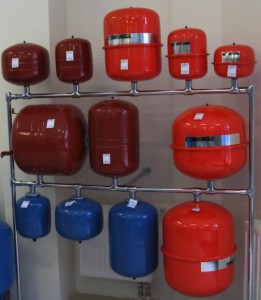
First of all, the volume of coolant for the heating system is taken into account. If the selection is made incorrectly and the volume is not enough, then cracks and water leaks will appear at the joints.
In addition, the pressure may drop below a safe minimum. This will lead to airing of the internal cavity of the tank, then urgent repairs will be required. Therefore, it is better to select a model based on the characteristics that the accompanying instructions contain.
The value of the initial pressure in the expansion tank connected to the cold heating network must match the static pressure of the system. The permissible discrepancy between the indicators can be + 30–50 kPa.
The tank must have a volume of at least 10-12% of the total volume of the coolant in the system heat supply. Such a volume will exclude the failure of the tank itself, and the entire system during a pressure surge.
When choosing a suitable model, you should also take into account the maximum allowable pressure at which the device can operate. In private housing construction, 4-5 bar is enough.
Membrane tanks protect the heating system from excessive temperature rise and regulate the level of pressure in it. Therefore, such devices are equipped with independent temperature and pressure sensors.
Mounting the device
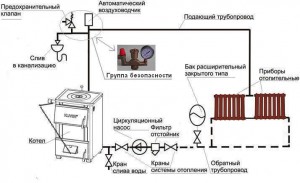
The installation is carried out in such a way that later maintenance can be carried out without hindrance.
A new tank, as a rule, has an excessive initial gas pressure, which is distributed throughout the volume. Before installing the expansion tank, it must be pumped up to a pre-calculated pressure.
The membrane tank should be installed before branching the water supply. It is necessary to ensure the drainage of water and make-up of the system. The room must be maintained at a positive temperature.
Additional loads are not allowed on the tank! If the container has a volume of 8 to 30 liters, then wall mounting is allowed. For large volumes, the equipment is placed on legs.
- It is better to choose an expansion tank with a margin: an extra volume within reasonable limits will not hurt. The new product arrives as usually with internal pressure of 1.5 kgf / cm2, and the pressure of the heating system is standardly 0.2 kgf / cm2 more - this is regulated by a nipple on the tank. It is better to position the tank so that the liquid comes from above.
- Often wall-mounted heating boilers initially equipped with superchargers and additional expansion tanks, which increase the final price, so when buying, you need to decide whether these devices are really needed. Does it make sense to purchase it with them if you plan to install a separate device for expansion?
- The minimum capacity of the tank should be 10% of the volume of all heating equipment. It may be more, but not less - this is fraught with breakdown and similar consequences. Another safety recommendation is to install a pressure gauge near the tank - so the user can quickly and timely adjust the pressure.
Expansion tanks closed type and hydraulic accumulators have approximately the same design: a strong metal shell, divided inside by a rubber membrane into two sections.
One section contains water, the other contains air. As the water pressure increases, the air compresses, the size of the air section decreases, and the membrane sags, the water displaces the air. On the one hand, the device has a connection to the water supply system, on the other, a spool for air pumping.
But the names of devices are assigned not because of design features, but according to their intended purpose.
purpose
- Expansion tanks are designed to compensate for the expansion of water due to heating in heating circuits, as well as hot water supply (DHW).
- Hydraulic accumulators are designed to accumulate volumes of water under pressure in water supply systems that have a pressure pump, to reduce the frequency of switching on this pump and to smooth out water hammer. Additional function- a supply of food-grade water up to 1/3 of the total volume of the tank.
The nuance is that the same device is used for both hot and cold water supply, but it can be called differently, depending on what it does in a particular scheme - it either accumulates (accumulates) a supply of water, or takes its excess during thermal extension.
- The design feature of the accumulator is more often that there is not a membrane inside, but a pear made of food rubber, which is pumped with water. Water does not come into contact with the tank body.
- The expansion tank for the heating system is made with a technical rubber membrane, which divides the body into two compartments, and the coolant (not always water) is in direct contact with the body.
How to distinguish
In appearance, all membrane tanks are similar to each other. There is an opinion that for the heating system they are red, and for water supply they are blue. But it is not completely true, as individual manufacturers use other colors.In fact, devices can be distinguished from each other only by technical specifications, which are indicated on the nameplates on the devices themselves:
- All devices for water supply, including for hot water supply - low temperature - up to 80 degrees C, but high pressure - up to 12 atm;
- expansion tanks for heating - elevated temperature - up to 120 degrees C, but low pressure up to 4 atm.
How water storage schemes work
The hydraulic accumulator in the water supply circuit smooths out pressure surges that occur when water is taken from the system, i.e. when the tap is opened, and reduce the number of pump starts, which should not be more than 50 times in 1 hour.When water is taken in the volume of the cup, the accumulator will give this volume, the pressure in the system will decrease, but not so much that the pressure switch turns on the pump. When taking a larger volume (for example, in the volume of a bucket), the pressure will drop so much that the pump will turn on and fill the device. 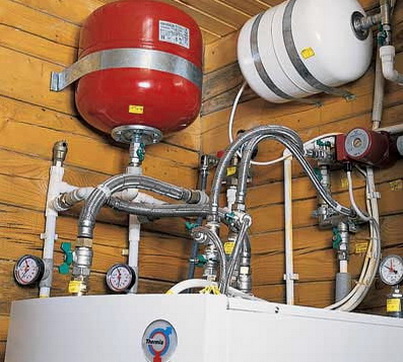
The expansion tank in hot water and heating systems receives an excess volume of water that occurs when it is heated.
If it wasn't similar device, then in a heated closed circuit, the pressure would very quickly rise above the critical one, since the liquid practically does not compress. This would lead to the release of water from the emergency pressure valve, which is usually set to a pressure of 3 atm.
In practice, if such a valve constantly passes water, then this indicates a malfunction of the storage device. If there is no emergency valve, then when heated, the weakest point of the system will be destroyed.
When an expansion tank is needed in a hot water system
This is a natural question, because hot water supply can be performed in different ways. If available flow heater, for example, a gas double-circuit boiler that heats a stream of water directly at its intake, then naturally an expansion tank is not needed.If in the system the water is heated in a closed large capacity boiler (more than 100 liters), then an expansion tank is required in addition to safety valve. Which is not right to hope for, since it is not at all designed for frequent operation and, with frequent switching on, it simply starts to flow.
How to choose the volume of the device for heating
The main question that arises for the user is how much volume of such a water-accumulating device is needed? At the same time, the user wants to purchase a smaller volume, since it is cheaper. But you need to purchase the one that fits the calculation.The volume of the expansion tank for heating will depend on the volume of the coolant in the system, the pressures - limit and set.
The formula for calculating the volume is shown in the photo:
The volume of the coolant is indicated in the design data, or it can be calculated by adding up all the internal volumes of the system elements, and finally, in the finished system, it can be calculated when pouring buckets.
For home system- calculation of the volume "without unnecessary torment" - 1/10 of the filled coolant.
What pre-pressure should be set
At the factory, the air chamber is normally filled with nitrogen to a pressure of 1.5 bar. At the same time, the membrane bends and is visible through the connection fitting. The safety of the factory pressure indicates that the membrane is intact and the device is suitable for use.But in the future, the membrane tank must be prepared for operation in a particular system. Exist following rules pressure definitions:
- In the cold water supply system, the accumulator is inflated with air at 0.2 atm. less than the lower setting of the pump pressure switch. More often, the lower value of the pressure switch is 1.4 atm. (pump start pressure) and the upper one - 2.8 atm. Accordingly, the initial pressure in the device is 1.2 atm. This setting will avoid water hammer when parsing water and rapid wear of the membrane.
- In a hot water supply system, the expansion tank is pumped with air to a pressure greater than the pressure at which the pump turns off (the upper limit of the pressure switch). In this case, the tank will not give cooled water to the water supply system. But you should not be afraid of stagnant water, the device is made in such a way that the pear is constantly washed by a stream of fresh water.
- In the heating system - the air chamber of the expansion tank is pumped up to a pressure of 0.2 atm. less than the pressure in cold system heating. Typically, the “idle” pressure in the system is 1.5 atm, respectively, it is pre-inflated to a pressure of 1.3 atm when the system is cold.
How to install
The general rule is that the connection to the system of any membrane tank should be at the bottom, and the air chamber at the top.But it should be taken into account that the accumulator can be deployed as you like, the connection to the water supply can be both from above and from the side, there is nothing special about this, if there are no objections from the manufacturer.
And the connection to the heating should be only from the bottom of the device. If this is not observed, and the air chamber is located below, then if the membrane fails, if cracks appear in it, the air will immediately go into the heating system and air it. If the air chamber is on top, then nothing terrible will happen when the membrane cracks, the device will still be able to work for a very long time in normal mode.
The photo shows an example of a heating circuit with a closed-type expansion tank connected to it.
The choice of accumulator, expansion tank. Service. Exploitation. Repair. (10+)
Hydraulic accumulator, expansion tank. Features of choice
A hydraulic accumulator and an expansion tank are designed for slightly different purposes, but are arranged in almost the same way, so I combined them in one article. The hydraulic accumulator is designed to accumulate water in the autonomous water supply system, to protect the system from overpressure, avoiding frequent switching on of the pump. The expansion tank is installed in the heating system. It protects it from excessive pressure, which can occur when water (or other coolant) expands from an increase in temperature. The key difference between a hydraulic accumulator and an expansion tank is that the expansion tank must operate at a sufficient temperature, to the accumulator for cold water no such requirements apply. But on the other hand, for most accumulators, there are high requirements for the quality of the membrane material, since they are used in the supply of water that can be eaten. For an expansion tank, such requirements are less critical.
Device, hydraulic accumulator / expansion tank diagram
These products are designed in the same way. There is a tank, which is divided into two zones by a membrane. Air is pumped into one zone, water or coolant is located in the other. Branch pipes for installation to the system are connected to the coolant area. An air check valve is connected to the air chamber, such as in car tires, for control measurements of pressure and pumping if necessary. The membrane is made of an elastic inert material such as rubber or special polymers.
Unfortunately, errors occur periodically in articles, they are corrected, articles are supplemented, developed, new ones are being prepared. Subscribe to the news to stay informed.
If something is not clear, be sure to ask!
Ask a Question. Article discussion. messages.
Good afternoon, is it possible to put an expansion tank instead of a hydraulic accumulator? Read answer...
Automation homemade heating burner. Scheme. With my own hands. Neg...
Homemade automation scheme heating burner in processing....
Gas in the house autonomously. Is it real? Personal experience. Review. Mounting errors...
Review of experience autonomous gasification, gas tank installations for liquefied gas. T...
Flame, burning, fire, torch. Theory. Smokes, smokes, goes out. Incomplete...
Why does the flame smoke or go out? Incomplete combustion - causes. What does the quality of...
How to fix a leak in the heating system, heating boiler ....
What to do with a small leak in the heating system?
Connecting a gas heating burner with your own hands ....
How to properly install, connect and adjust a gas heating burner ...








